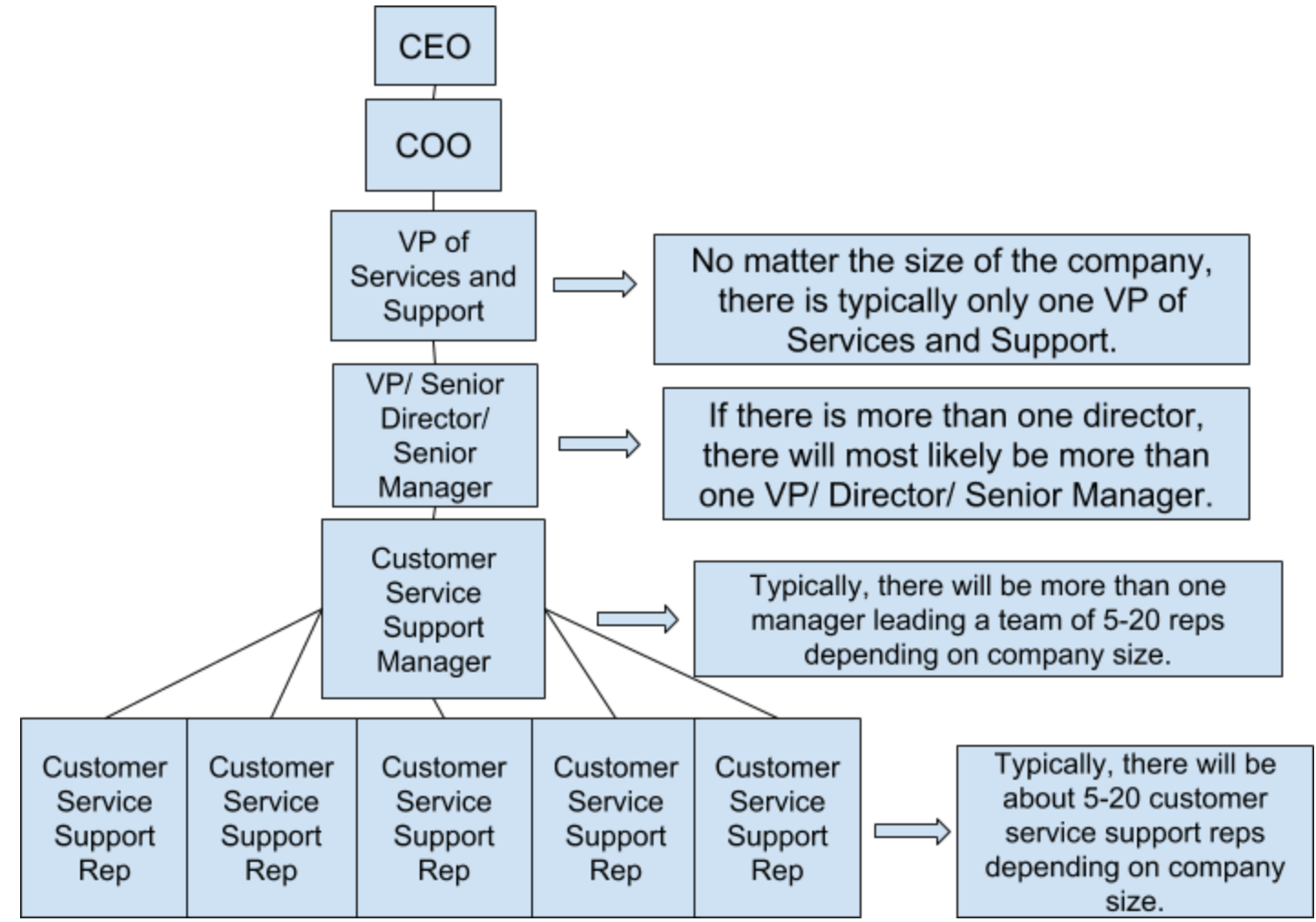This is just one of the millions of reasons a customer might reach out to a given company’s customer service and support department. So you can probably imagine how difficult it’d be to run your business and maintain great customer relationships without a customer service and support department complete with talented, patient, and thoughtful employees — like Jeff!
Customer service and support employees, often referred to as representatives and managers, work hard every day to ensure your customers have positive experiences with your company. They do this by answering inquiries, resolving problems, and addressing concerns so your customers want to continue doing business with you. Let’s talk more about the differences between representatives and managers within customer service and support.
Customer Service and Support Managers vs. Representatives
At most companies, the people with whom the customer/ client actually chats directly when they have a question, complaint, or comment, are called customer service and customer support representatives. On the other hand, customer service and support managers are the people who oversee these reps. Customer service and support managers will usually only speak with a client or customer directly if an issue is escalated by one of their reps.
Customer service and support managers lead, coach, and train representatives. They provide their reps with goals and feedback to help them improve the service and support they provide your customers. They can step in and assist a representative in any given situation with a customer if that issue is escalated. Lastly, managers also communicate with their higher-ups regularly to ensure all of their expectations for the department are also being met.
Your customer service and support department is critical to the success of your business. And since customer service and support managers dictate the way your representatives communicate with and assist your customers, let’s cover how to train and develop quality managers for your company.
In this guide, we’ll review the skill set you should look for in your customer service and support managers, the structure of a customer service and support department, and how to build your department.
But first, an important question: What’s the difference between customer service and customer support?
Customer Service vs. Customer Support
Customer service managers work proactively — they lead representatives to solve your customers’ problems before they even realize they exist. To do this, managers may organize their reps in teams based on function, determine which channels certain reps should be working — such as email, phone, or chat — and collaborate with other customer service managers and higher-ups to determine an overall customer service strategy for all managers and reps. Customer service managers oversee the teams of customer service reps and will typically only speak with customers directly if a rep escalates an issue.
Customer support managers work reactively — they lead representatives to resolve your customers’ inquiries via different modes of communication such as phone, email, chat, and social media. Support representatives are typically the first point of contact your customer will have with your company’s customer service team.
Customer support managers oversee teams of customer support reps and, similar to customer service managers, they’ll typically only speak directly with customers if a rep escalates an issue.
Learn more about how to put your customers first and continually engage and delight them.
Although customer service and customer support functions vary slightly, the imperative skills, characteristics, and qualities of customer support and service managers are the same, and they have very similar job responsibilities. For the purpose of this guide, we’ll refer to customer service and support managers interchangeably.
Now, let’s cover some of these skills you’ll want your customer service and support managers to have to ensure they’ll be successful assets to your company.
Here are ten customer service and support manager skills we believe are critical to their ability to succeed.
1. Communication
Your customer service and support managers must be able to communicate with their reps to ensure all customers are taken care of in a professional manner that meets your company’s standards. They must also be able to successfully communicate directly with the customer if an issue is escalated to them to resolve their issue.
2. Patience
Managers require patience in a variety of situations. For example, they must be patient while teaching your reps how to reach different resolutions for your customers. Not every rep is going to catch onto the material they’re being taught in the same amount of time — some may require more assistance or coaching.
3. Problem Solving
All of your customer service and support employees — managers included — are problem solvers. They have to find a way to resolve every customer’s issue and answer a variety of different inquiries every day as efficiently as possible.
4. Diplomacy
Customer service and support managers have to be diplomatic in their interactions with your reps and customers. This means they need to be sensitive to specific scenarios and situations when trying to reach any type of solution or agreement with both their reps and customers.
5. Motivation
Managers need to motivate each of their reps to do their jobs to the best of their ability. If representatives feel motivated to work hard and succeed at your company, they’ll be more likely to positively impact your customers — meaning your business will have a greater chance of retaining those customers.
6. Trust
A great customer service and support manager is one who coaches and teaches reps how to do their work and then trusts them to do it well on their own. Maintaining this level of trust prevents your reps from feeling as though they’re being micromanaged.
7. Empathy
Similar to patience, empathy is another critical characteristic people that all customer-facing and managerial roles should have. When your managers show empathy while working with reps and customers, they’re able to thoughtfully communicate and reach a resolution that meets everyone’s needs.
8. Vision
Your managers need to have vision. An effective leader is one with team-oriented goals and aspirations. Without vision, your service and support managers wouldn’t challenge your reps to improve or achieve anything new.
9. Work Under Pressure
Customer service and support managers need to be able to work well under pressure.
Typically, they’ll have multiple representatives communicating with customers simultaneously — meaning there’s a chance that situations may arise in which they need to assist more than one rep or customer.
10. Great Listener
One of the main jobs of a customer service and support manager is listening. In terms of their reps, managers need to listen to them describe the assistance they may need while working with their customers. Managers also need to listen to their reps describe feedback regarding their roles.
In terms of customers, managers must also be great listeners — when reps escalate an issue, they need to listen and understand the problem so they’re able to come up with a solution that satisfies the customer.
In terms of working with fellow managers and higher-ups, managers need to be great listeners so they can thoughtfully contribute to and understand discussions about the growth and goals of the department.
Now that we’ve covered the skills that your customer service and support managers should have, let’s take a look at what ways in which you can actually build your service and support department.
Customer Service Department Structure
Depending on your company’s size, industry, and resources, the structure your customer service and support department may look a bit different than others. This section will give you a general understanding of some of the ways you could build your department and how your managers will fit into its structure.
Typically, a customer service and support department includes one or more specialized teams, each of which serves a specific function — such as account and billing. Each of these specialized teams may be made up of about 5-20 customer service and support representatives.
Each of these teams of 5-20 reps is led by a manager who’s also specialized in their specific function.
All of the specialized support and service managers are led by a senior director, senior manager, or vice president, depending on their title. There might be 1-7 of these people overseeing all of the work done by the managers and representatives.
Lastly, there’s a vice president of services and support who manages the entire department and reports directly to the company’s COO and CEO.
Here’s a visual representation of a customer service and support department to help you better understand the structure.

Now that you have an idea about the general structure of a customer service and support department, how should you go about actually building your company’s department? What will you need to complete its structure? We’ll cover that now.
How to Build a Customer Service Department
There are five steps you should work through when building your customer service and support department. These are universal to every business no matter your company size, industry, or resources.
1. Determine your customer service and support team’s function
If you have a smaller company with fewer resources, you might also have a small support team with fewer specialized service and support departments. But, your service and support teams should still serve a specific purpose and function to keep things organized, even if that’s simply separating the team’s tasks based on the differences between customer service vs. customer support as we discussed earlier. Then, as your company grows, you’ll continue to create more specialized teams with specific functions.
Once your company grows and has multiple products and departments, your customer service and support team should be split into specialized groups with specific functions. This could be something like account and billing. Doing this ensures your team of reps and managers will have the necessary answers and knowledge to appropriately support and assist customers.
2. Hire remarkable people
Customer service and support managers require a specific skill set to be successful. That’s why finding remarkable and talented people who exemplify the qualities and characteristics you want your company to be known for is crucial. After all, these are the people representing your brand, leading your reps, and communicating with your customers every day.
3. Set case-by-case support plans
Every person is different — therefore, your customer service and support managers should make sure their reps treat every customer interaction and inquiry that way. Although multiple people may have similar reasons for contacting your service and support department, that doesn’t mean every person needs and deserves the same, scripted response. To combat this, make sure your managers create plans specific to different issues that your service department might come up against.
Here are some examples of case-by-case service and support plans:
- Set up first call resolution plans for reps to use when dealing with your customers’ most common problems, complaints, and inquiries. These plans allow representatives to fix the issue during their initial conversation so they’re more likely to retain that customer by turning their negative situation into a positive experience.
- Use your company’s buyer personas to consider other or less common reasons someone might contact your service and support departments to ensure managers prepare their reps for a number of possible situations and problems a customer of yours may have. This way they know exactly how to tackle them and find a resolution for that customer in a timely manner.
- Put guidelines in place for what reps should do in a situation where there isn’t already a specific plan in place. This should include details about how they can escalate an issue if necessary.
4. Have all of the customer support tools and software your team needs
Your customer service and support teams won’t be successful without the right tools and software. These resources allow your managers and reps to reach solutions for your customers. Examples of the tools and software your customer service and support team may need include:
- Ticket system, which keeps track of your customers’ requests.
- Customer feedback system, which allows you to understand your customers' needs and what delights them.
- Knowledge base, which makes it easy for your customers to find what they’re looking for.
- Live chat and universal inbox, which allows you to communicate with your online visitors in real-time.
- Employee scheduling software, which allows you to organize and manage all of your employees’ work shifts.
By simply talking to your service and support managers and thinking about the needs of your personas and customers, you’ll be able to determine the customer service and support software and tools your teams need.
Learn more about customer service software that will help you grow your business and build positive relationships with your customers.
5. Measure the success of your department regularly
By regularly measuring the success of your department, you’ll be able to determine whether or not your managers are leading your reps in a way you feel meets both their expectations as well as company expectations. You’ll also be able to determine whether or not you feel your reps are managing customers in a way that meets company standards.
Learn how to calculate your company’s key customer service and support metrics.
Every interaction between a service or support rep and a customer should be recorded for future reference and analysis by managers. Additionally, service and support managers should conduct check-ins with their reps to review their work and discuss any necessary improvements that should be made.
To measure the success of your entire service and support team, you and your managers can conduct customer feedback surveys with the help software like Hotjar. You can also use a Net Promoter Score (NPS) — an effective way to learn about how your customers view your company.
Now that you know how to build your service and support department, you might be wondering what your managers will actually be doing every day.
These are some of the more common customer service and support manager responsibilities, but it’s important to remember your manager’s responsibilities will still vary based on your company type, industry, size, customers, and resources.
Handle Customer and Staff Complaints
It’s the job of your managers to ensure all reps are patiently and effectively dealing with all customer issues, complaints, and inquiries. You’ll want your managers to make sure your customers feel heard, accommodated for, and treated fairly while working with reps.
Resolve Customer Inquiries
Managers should teach reps how to resolve various customer inquiries, like questions about your products. Your managers should coach and train your reps so they know how to handle different types of situations and customers. Managers should also be prepared to resolve any customer inquiries themselves if they are escalated.
Manage Financial Discrepancies
Managing financial discrepancies, such as refunds and exchanges, may also be tasks your managers oversee. Typically these types of discrepancies are simple for reps to fix and won’t need to be escalated to a manager.
Effectively Lead Customer Service Reps
Your managers lead customer service and support representatives every day. Effectively leading a team of reps means the manager coaches reps to achieve team goals, solve for every customers’ needs, and positively impact the lives of any customer who contacts the department. By leading reps this way, managers are able to create long-lasting relationships between your company and customers.
Understand Your Company’s Products Inside and Out
Customer service and support managers (and representatives) must know your company’s products inside and out. This is the only way they’re going to be able to handle the variety of possible questions, concerns, and comments your customers are contacting them about.
Maintain Strong Communication Skills
Customer service and support managers need to have excellent communication skills to ensure reps are well-equipped and trained to help customers work through any issue. Strong communication skills also help your managers promote team-building and team collaboration among reps.
Set Clear Goals For the Department
Managers should set attainable goals for their department and reps so everyone is able to work towards a common target together. A great way to do this is to have your managers set SMART goals, which are concrete, quantifiable, and realistic.
Get Started
Customer service and support managers serve a critical role in all companies. They defuse all issues and problems that your customer’s face and turn negative customer or employee experiences into positive ones. So, determine the size and structure of the customer service and support department your company needs and get started searching for the perfect manager or managers to lead your reps.




![Customer Service Culture: 7 Effective Ways to Build It [+ Examples]](https://53.fs1.hubspotusercontent-na1.net/hubfs/53/customer-service-culture%20(1).webp)




![How to Set 'Smart' Customer Service Goals [Examples]](https://53.fs1.hubspotusercontent-na1.net/hubfs/53/customer-service-goals_3.webp)

